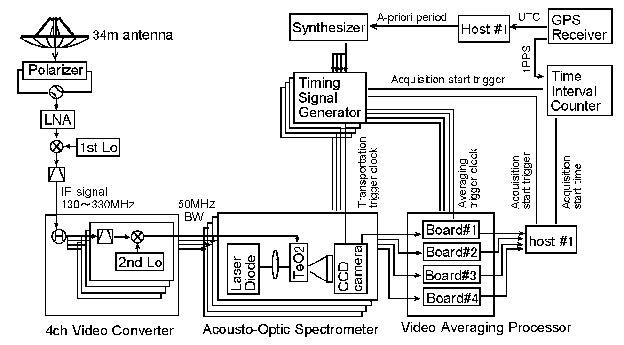
Figure 1. Block diagram of millisecond pulsar observation system at CRL.
1Communications Research Laboratory
4-2-1 Nukui-kita, Koganei, Tokyo 184-8795, Japan
2 Kashima Space Research Center
Communications Research Laboratory
893-1 Hirai, Kashima, Ibaraki 314-0012, Japan
One way to improve a system's sensitivity is to expand its observing bandwidth. For pulsar observations, however, we must note the dispersion effect caused by interstellar plasma. Owing to this effect, observed pulse shape is broadened as the receiving bandwidth increases. In order to avoid this problem, a wide-band signal must be divided into narrow bands at first, and recombined after canceling the dispersion delay in each narrow band. Such a process is called de-dispersion [Lyne and Graham-Smith, 1990]. A filter-bank method is popular for de-dispersion, but we use an AOS instead of a filter-bank method in our system.
AOS is a spectrometer using an acousto-optic device such as a single crystal of TeO2 for spectrum analyzing. This spectrometer can divide a wide band signal into many narrow channels simultaneously by a small crystal, so it makes the system simple and compact.
Long integration time is another way to improve sensitivity, which is achieved by accumulating many pulses. For this purpose we developed a high speed averaging processor which can average pulses 224 times without data transportation to the host computer. It can eliminate dead time in data processing by performing internal calculations during the next data acquisition, and we can obtain the averaged data almost in real time.

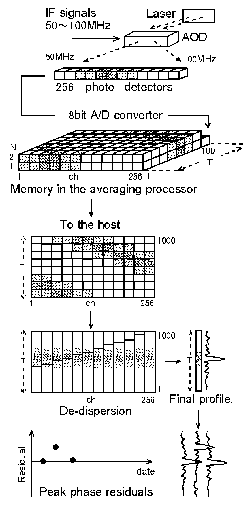
| Antenna diameter | 34m |
| Observation frequency | 2120 - 2320 MHz |
| Total bandwidth | 200 MHz (50 MHz X 4 units) |
| Frequency resolution | 200 kHz (50 MHz / 256 ch) |
| Time resolution | 16 usec |
| A/D converter resolution | 8 bit |
| Number of pulse-addition | 20 - 224 |
Figure 1 is a block diagram of our observation system using the 34m antenna at Kashima Space Research Center of CRL, and Figure 2 shows its data flow. The system's parameters are listed in Table 1. We use 2GHz band for pulsar timing observations. An IF signal with 200MHz bandwidth is divided to 50MHz X 4units at video converter. Each 50MHz bandwidth is divided to 200kHz X 256ch by the AOS, then transported to the video averaging processor serially. This transporting time for one line is 12.8 usec (=50ns X 256ch), which limits time resolution. When the transportation trigger is set to 1/100 of the pulsar period, the time resolution becomes about 16 usec for PSR1937+21. The video averaging processor works as an 8-bit A/D converter, and an averager which allows 224 pulses' addition (= 7 hours' integration for PSR1937+21) in each channel. At the host1, the averaged data of each channel are combined after the dispersion-delay calibration carried out in 1/1000 steps of pulsar period, and final pulse profile is defined. From this profile, the peak phase is defined as arrival pulse timing. Host2 calculates the a-priori pulse period, and supplies it in real time to the synthesizer which controls the averaging trigger clock of the timing signal generator. For this calculation, we use the program TEMPO which is the Princeton pulsar timing analysis package [Foster and Backer, 1990]. The reference clock of this system is synchronized with UTC via the GPS satellites. The difference between UTC and the internal clock of the timing signal generator is monitored by a time interval counter.
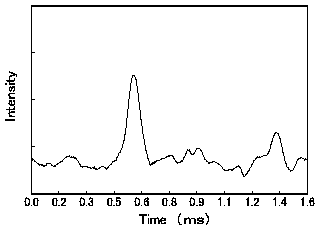
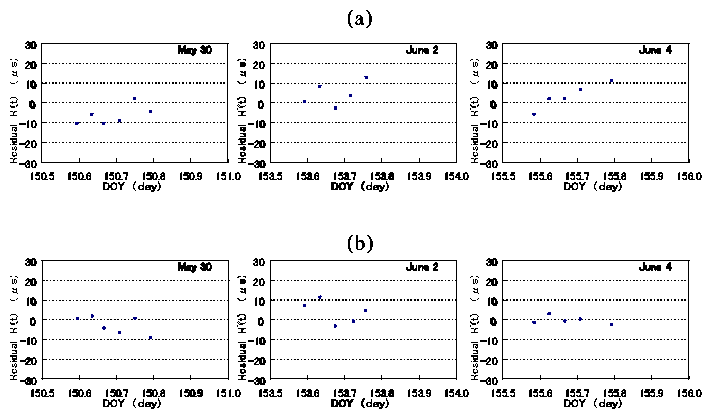
We carried out the preliminary observations of PSR1937+21 at 2GHz band.
Figure 3 shows the pulse profile made after averaging 524288 pulses (=
integrating about 14 minutes). From such averaged profiles, peak phases are
defined. Figure 4 shows the residuals R'(t)s calculated as follows, which shows
the phase fluctuation:

here phiobs(t) is an observed peak phase,
phicalc(t)
is a calculated a-priori
phase, and Rave is an average of all R(t)s over three days. Residuals observed
on May 30, June 2, and June 4 tend to increase in one day (Fig. 4(a)). We
suppose it is due to the mismatch of a-priori calculation, because we used the
old database made by old TEMPO (VAX version) in these observations. Then we
corrected the observed data by using new TEMPO (UNIX version). The UNIX version
uses a newer ephemeris compared with that of the VAX version. After this
correction, the residuals' drift seems to be flat (Fig.4(b)), and the standard
deviation is improved to 4.8 usec from 7.2 usec. From these results,
it seems to be better to use UNIX TEMPO.
After June 19, we use UNIX TEMPO for the
observations,
but some problems still
remain. Figure 5 shows the observation results from June 19 to July 25, and the
residuals show a systematic trend. Perhaps it is because of the misuse for the
program or hardware problem, and we are now trying to clarify the cause.
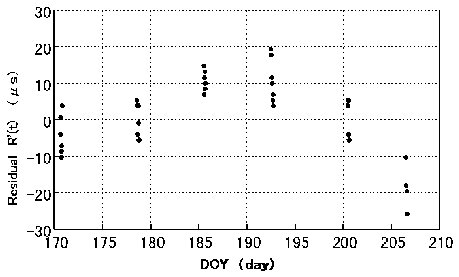
Foster,R.S., L.Fairhead, and D.C.Backer, A spectral study of four millisecond pulsars, Astrophys.J., 378, 687-695, 1991.
Fruchter,A.S., M.Tavani, and D.C.Backer, Millisecond pulsars: A decade of surprise, Astronomical Society of the Pacific Conference Series, 72, 345-356, 1995.
Goutzoulis,A.P. and I.J.Abramovitz, Digital electronics meets its match, IEEE Spectrum, 21-25, August 1988.
Hanado,Y., H.Kiuchi, S.Hama, A.Kaneko, and M.Imae, Millisecond pulsar observation at CRL, J.Commun. Res. Lab., 40, 55-62, 1993.
Lyne,A.G. and F.Graham-Smith, Pulsar astronomy, Cambridge Univ. Press, 27-28, 1990.
Taylor,J.H., Millisecond Pulsars: Nature's Most Stable Clocks,
Proc.IEEE, vol.79, No.7, pp.1054- 1062, July, 1991.